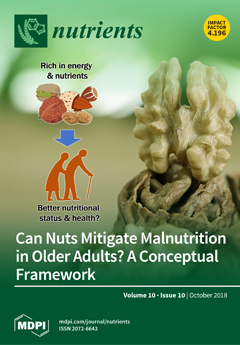1
Institute of Food and Health, University College Dublin, Dublin D04 V1W8, Ireland
2
Department of Food, Nutrition & Health, University of British Columbia, Vancouver, BC V6T 1Z4, Canada
3
Nutri Psy Consult, 91 rue de la Santé, 75013 Paris, France
4
Center for Public Health Nutrition, University of Washington, Seattle, WA 98195-3410, USA
5
Division for Risk Assessment and Nutrition, The National Food Institute, Technical University of Denmark, 2800 Kgs. Lyngby, Denmark
6
Cereal Partners Worldwide, CH-1350 Orbe, Switzerland
7
Nutrition Innovation Centre for Food and Health (NICHE), Ulster University, Coleraine BT52 1SA, UK
8
Department of Pharmaceutical and Health Sciences, Faculty of Pharmacy, CEU San Pablo University, 28668 Madrid, Spain
9
GENUD (Growth, Exercise, Nutrition and Development) Research Group, Universidad de Zaragoza, Instituto de Investigación Sanitaria Aragón (IIS Aragón), Instituto Agroalimentario de Aragón (IA2), Centro de Investigación Biomédica en red Fisiopatología de la Obesidad y Nutrición (CIBEROBN), 50009 Zaragoza, Spain
10
Bell Institute of Health and Nutrition, General Mills, Minneapolis, MN 55427-3870, USA
11
MS-Nutrition, 13385 Marseille CEDEX 5, France
12
Swiss Distance University of Applied Sciences, Althardstrasse 60, Regendorf-Zürich CH-8105, Switzerland
add
Show full affiliation list
remove
Hide full affiliation list
Abstract
The International Breakfast Research Initiative (IBRI) set out to derive nutritional recommendations for a balanced breakfast using a standardized analysis of national nutrition surveys from Canada, Denmark, France, Spain, UK and the US. In all countries, the frequency of breakfast consumption by age
[...] Read more.
The International Breakfast Research Initiative (IBRI) set out to derive nutritional recommendations for a balanced breakfast using a standardized analysis of national nutrition surveys from Canada, Denmark, France, Spain, UK and the US. In all countries, the frequency of breakfast consumption by age was high and U-shaped with children and older adults having a higher frequency of breakfast consumption. Breakfast contributed 16% to 21% of daily energy intake. In all countries, breakfast was a carbohydrate- and nutrient-rich meal, providing more carbohydrates (including sugars), thiamin, riboflavin, folate, calcium, potassium, and magnesium, and less vitamin A, fats and sodium relative to its contribution to daily energy intakes. Breakfast consumers were stratified by tertiles of the Nutrient Rich Foods (NRF) index, used as a measure of diet quality. Breakfast intakes associated with the top tertile of NRF, along with the Codex Alimentarius international food standards and World Health Organization (WHO) diet guidelines, were used to derive the proposed nutrient recommendations. The goal was to preserve the nutrient density of existing breakfasts, while addressing concerns regarding added sugars, saturated fats, dietary fiber, and vitamin D. This initiative is unique in seeking to derive nutrient recommendations for a specific meal using the observed nutritional profile of such meal.
Full article






